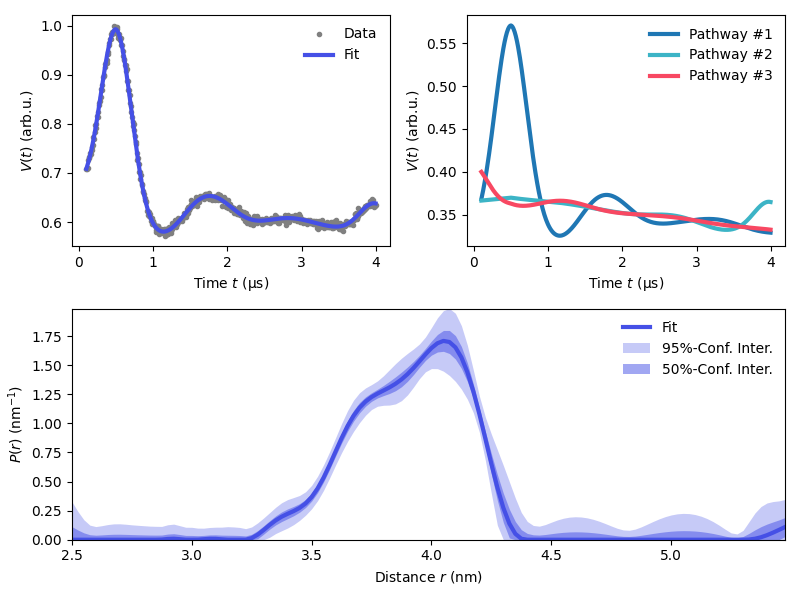Note
Go to the end to download the full example code.
Analysis of a 4-pulse DEER signal with multiple dipolar pathways¶
Fit a 4-pulse DEER with multiple dipolar pathways and display the individual pathway contributions.
import numpy as np
import matplotlib.pyplot as plt
import deerlab as dl
# File location
path = '../data/'
file = 'example_4pdeer_2.DTA'
# Experimental parameters
tau1 = 0.5 # First inter-pulse delay, μs
tau2 = 3.5 # Second inter-pulse delay, μs
tmin = 0.1 # Start time, μs
# Load the experimental data
t,Vexp = dl.deerload(path + file)
# Pre-processing
Vexp = dl.correctphase(Vexp) # Phase correction
Vexp = Vexp/np.max(Vexp) # Rescaling (aesthetic)
t = t - t[0] # Account for zerotime
t = t + tmin
# Distance vector
r = np.arange(2.5,5.5,0.025) # nm
# Construct the model
experiment = dl.ex_4pdeer(tau1,tau2, pathways=[1,2,3])
Vmodel = dl.dipolarmodel(t,r,experiment=experiment)
# Fit the model to the data
results = dl.fit(Vmodel,Vexp)
# Print results summary
print(results)
Goodness-of-fit:
========= ============= ============= ===================== =======
Dataset Noise level Reduced 𝛘2 Residual autocorr. RMSD
========= ============= ============= ===================== =======
#1 0.005 1.165 0.031 0.005
========= ============= ============= ===================== =======
Model hyperparameters:
==========================
Regularization parameter
==========================
0.064
==========================
Model parameters:
=========== ========= ========================= ====== ======================================
Parameter Value 95%-Confidence interval Unit Description
=========== ========= ========================= ====== ======================================
lam1 0.307 (0.302,0.313) Amplitude of pathway #1
reftime1 0.500 (0.493,0.508) μs Refocusing time of pathway #1
lam2 0.058 (0.049,0.066) Amplitude of pathway #2
reftime2 3.991 (3.962,4.020) μs Refocusing time of pathway #2
lam3 0.060 (0.046,0.074) Amplitude of pathway #3
reftime3 0.009 (-0.048,0.048) μs Refocusing time of pathway #3
conc 101.633 (83.941,119.325) μM Spin concentration
P ... (...,...) nm⁻¹ Non-parametric distance distribution
P_scale 1.161 (1.160,1.163) None Normalization factor of P
=========== ========= ========================= ====== ======================================
# Extract fitted dipolar signal
Vfit = results.model
# Extract fitted distance distribution
Pfit = results.P
Pci95 = results.PUncert.ci(95)
Pci50 = results.PUncert.ci(50)
plt.figure(figsize=[8,6])
violet = '#4550e6'
green = '#3cb4c6'
red = '#f84862'
plt.subplot(221)
# Plot experimental data
plt.plot(t,Vexp,'.',color='grey',label='Data')
# Plot the fitted signal
plt.plot(t,Vfit,linewidth=3,color=violet,label='Fit')
plt.legend(frameon=False,loc='best')
plt.xlabel('Time $t$ (μs)')
plt.ylabel('$V(t)$ (arb.u.)')
plt.subplot(222)
lams = [results.lam1, results.lam2, results.lam3]
reftimes = [results.reftime1, results.reftime2, results.reftime3]
colors= ['tab:blue',green, red]
Vinter = results.P_scale*(1-np.sum(lams))*np.prod([dl.bg_hom3d(t-reftime,results.conc,lam) for lam,reftime in zip(lams,reftimes)],axis=0)
for n,(lam,reftime,color) in enumerate(zip(lams,reftimes,colors)):
Vpath = (1-np.sum(lams) + lam*dl.dipolarkernel(t-reftime,r)@Pfit)*Vinter
plt.plot(t,Vpath,linewidth=3,label=f'Pathway #{n+1}',color=color)
plt.legend(frameon=False,loc='best')
plt.xlabel('Time $t$ (μs)')
plt.ylabel('$V(t)$ (arb.u.)')
# Plot the distance distribution
plt.subplot(212)
plt.plot(r,Pfit,linewidth=3,color=violet,label='Fit')
plt.fill_between(r,Pci95[:,0],Pci95[:,1],alpha=0.3,color=violet,label='95%-Conf. Inter.',linewidth=0)
plt.fill_between(r,Pci50[:,0],Pci50[:,1],alpha=0.5,color=violet,label='50%-Conf. Inter.',linewidth=0)
plt.legend(frameon=False,loc='best')
plt.autoscale(enable=True, axis='both', tight=True)
plt.xlabel('Distance $r$ (nm)')
plt.ylabel('$P(r)$ (nm$^{-1}$)')
plt.tight_layout()
plt.show()

Total running time of the script: (0 minutes 24.805 seconds)